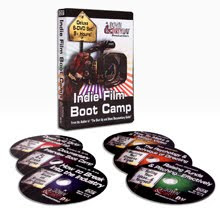As a new contributor to the Down and Dirty DV blog, I'd like to offer some insight into a chieving high production value without breaking the bank. My first topic: Fight Sequences.
 What do El Mariachi , Laws of Gravity, and Bloodsport all have in common? They're low-budget action films that don't suck. With very little money and a lot of ingenuity, these directors created interesting and unique fight sequences that people still marvel at today. Just because you have a budget smaller than your tab at 7 Eleven doesn't mean you can't make a believable action flick.
What do El Mariachi , Laws of Gravity, and Bloodsport all have in common? They're low-budget action films that don't suck. With very little money and a lot of ingenuity, these directors created interesting and unique fight sequences that people still marvel at today. Just because you have a budget smaller than your tab at 7 Eleven doesn't mean you can't make a believable action flick.
 2) Long Lens- Shoot close contact shtos with a long lens. The long lens compresses the distance between objects so a punch that actually misses the face by a couple inches will look like a person has actually hit their target on film.
2) Long Lens- Shoot close contact shtos with a long lens. The long lens compresses the distance between objects so a punch that actually misses the face by a couple inches will look like a person has actually hit their target on film.
 What do El Mariachi , Laws of Gravity, and Bloodsport all have in common? They're low-budget action films that don't suck. With very little money and a lot of ingenuity, these directors created interesting and unique fight sequences that people still marvel at today. Just because you have a budget smaller than your tab at 7 Eleven doesn't mean you can't make a believable action flick.
What do El Mariachi , Laws of Gravity, and Bloodsport all have in common? They're low-budget action films that don't suck. With very little money and a lot of ingenuity, these directors created interesting and unique fight sequences that people still marvel at today. Just because you have a budget smaller than your tab at 7 Eleven doesn't mean you can't make a believable action flick.Most fight sequences today require a lot of money, people, and expertise. But if you follow my advice, you won't need any of those things.
Most importantly, you must pay attention to choreography. If you and your actors haven't rehearsed interesting choreography (over and over again), no amount of editing or tricky camera angels will make up for it. This is the one part of any low-budget film that CANNOT be improvised.
And remember, always rehearse slowly at first and then build up to a normal pace. if you can't think of cool moves and don't have the money for a moderately-trained professional, just rent a few films with hand-to-hand combat and watch them in slow motion.
And remember, always rehearse slowly at first and then build up to a normal pace. if you can't think of cool moves and don't have the money for a moderately-trained professional, just rent a few films with hand-to-hand combat and watch them in slow motion.
For those of you who don't know how to properly film a fight sequence, here are some tips on shooting action scenes:
1) Movement- The most obvious. Incorporate movement into your choreography (i.e. Person A drags Person B across room, Person B ducks and pushes Person A a few feet and onto a table, etc) and follow the movenment of one character with the camera without changing height or distance. This creates a really smooth, organic flow of movement. As the characters stop at one point, you can change the height, distance, or who you follow and then continue on.
 2) Long Lens- Shoot close contact shtos with a long lens. The long lens compresses the distance between objects so a punch that actually misses the face by a couple inches will look like a person has actually hit their target on film.
2) Long Lens- Shoot close contact shtos with a long lens. The long lens compresses the distance between objects so a punch that actually misses the face by a couple inches will look like a person has actually hit their target on film.3) Two Takes, Two Lenses- Do two takes for each setup, but for the second take, change the lens size and the camera speed. You double your types of shots without changing your setup!
4) Sound Is Your Savior- A fight sequence really comes together in post production. Aside from careful and quick editing, sound will be your best friend. Punch watermelons to simulate face blows. Break celery for neck breaks. Don't forget minor impact sounds such as clothes rubbing or someone being pushed up against a wall.
Lindsay Curren has written a great article with even more tips on how to make your scene even more dynamic.
As you can see, by following a few simple rules, you can make something as easy as two dudes fighting in an empty room look exhilarating.
Good luck and happy filmmaking!
Until next time...











